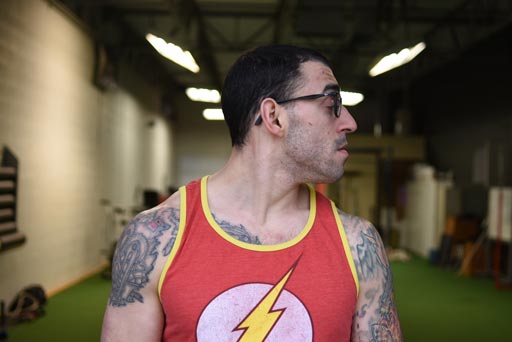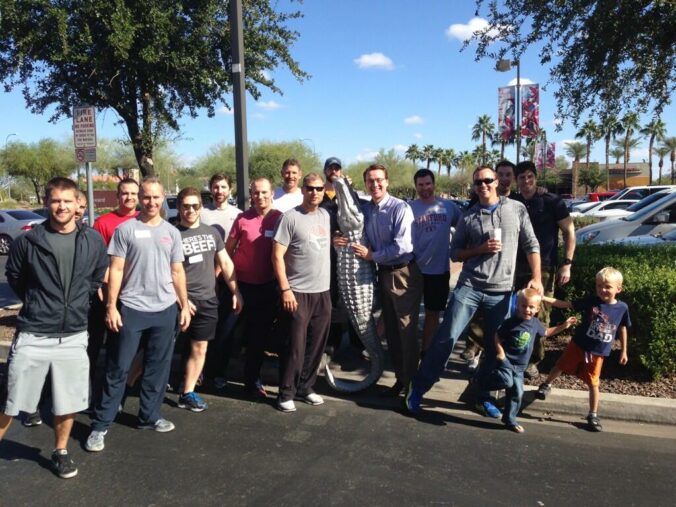One of my goals for my non-athlete athletes (the teachers, moms, doctors) is neutrality.
But what does that even mean? What’s not neutral about me?
It’s reminds me of the intro in Van Halen’s “Hot For Teacher”. I don’t feel asymmetrical.

Asymmetry is Natural
Forgive the morbid visual, but if you cut yourself right down the middle and looked at your right and left insides, no part of your rational brain would think, “I’m a perfectly symmetrical human being.”
And what does that make you? That makes you and I part of the same Homo sapiens family. That’s it. Asymmetry isn’t weird, it’s normal. It’s necessary.
The biggest internal asymmetries that I like to point out to clients are the size of the thoracic diaphragm, the side of the liver, and side of the heart. These make us really good at standing on our right legs and breathing into our left chest wall.

And going back to Van Halen, most people I’m cuing won’t feel asymmetrical until I get them neutral. If you live a life on your right leg (hint: you do), you’d feel weird on your left leg, too! Remember the story I wrote about from that course a few weeks back?
The Origins Project
It’s impossible to say where or why or how this asymmetry has come about to be so prevalent, but I can make a guess (because that’s what the interwebz is so good for: speculation).
It makes sense to me that this asymmetry has come about from natural selection, just like, you know, everything else. The infamous Pat Davidson recently shared a quote with me that sheds some light on the topic from the point of view of a physicist.
“…right-handed DNA for all is the rule. Evolution plays an essential role in this. As only like spirals can link to make a double helix, there is no advantage if some of us had right and others left, or if we had a mix of both. It appears essential for effective procreation, that the half provided by the male matches that from the female, and the most efficient way is if they have only one and the same handedness. While this does not explain how and when the asymmetry in the amino acids of our DNA originated, evolutionary advantage aided by the vastness of time could be the cause.”
-Frank Close, “Lucifer’s Legacy”, p. 76
If you think about the beginning of life on Earth, making two sets of DNA would, at best, halve the chances of life forming. So these all-right-sided DNAs had a huge advantage in making copies of themselves.
Defining Neutrality
If I go any further on origins, I’ll be stepping out of my bounds of education, so let’s shift gears. What am I examining to see whether or not you’re neutral?
Well, as someone who works with bodies and weights, the best way I know how to attack the situation is through movement. Even though not every change is orthopedic, these changes are the most tangible to you and I.
So I do some tests. I look at the position of your lower body with an Adduction Drop Test. This will tell me a lot, but most specifically, it tells me the position of your pelvis. Can you adduct?
There are some other accessory lower body tests that I’ll do to confirm my findings because I mess up sometimes. Hip motion tells me a lot of things.
Then I do some tests to look at the position of your upper body. An Apical Expansion test is the first time I ask you to breathe for me. Can you exhale on the left side? Can you inhale on the right side?
Then I’ll confirm my findings, which I find is especially important for the Apical Expansion test because it’s hard to judge the results without tester bias. Shoulder motion tells me a lot of things.
I always look at the way your neck moves, too. This Cervical Axial Rotation test is important because your neck motion tells me a lot of things.
If I can get all of these tests cleared, you’re neutral. If you’re neutral, you can effectively move side to side. You can walk with two legs instead of a right leg and a left kickstand. You can aspire. You can create.
Based on the natural asymmetry I was talking about earlier, I’m able to make some test predictions. If all of these predictions prove correct, I would call you “classic”. A classic left AIC, right BC, right TMCC. A classic human.
Then I can give you an exercise or push on your ribs to help you get neutral.
The Epilogue
After you get neutral (note the wording; I’m not doing it, you are), I give you some homework to make it stick. Neutrality isn’t a forever-defined state.
This reminds me of a tenured client I’ve worked with many times at IFAST. She got neutral months ago and was so proud of the progress she’s made. I imagine me watching this is what it feels like when parents see their child walk for the first time.
Then she got busy at work, started sleeping less, eating worse, not coming into the gym consistently, and getting neck problems. I was able to look at her one-on-one and found out that she’s not neutral anymore. What gives?
The state of your system is dependent on so many factors: what you see, what you hear, the exercises you’ve been doing, what has happened to you in the past, who’s around you… Any perception of threat steals your neutrality and puts you into survival mode. What happens for someone like our client in this case is she forgets what it feels like to be neutral. My job is now to remind her. But how?
For some people who aren’t too far locked into the normal, asymmetrical pattern, the task I give you might be to find your left heel a few times a day while you’re at work. This could be enough to remind your body that you have a left side that likes attention, too.
For most people, I’m going to give you some exercises to do at home and in the gym. You may have years of adaptations and compensations that we need to combat, and those tests I listed above tell me which of these we should focus on. And if you’re trying to get stronger and healthier, these exercises can help mitigate the negative effects of weight training.
Most commonly, I see a locked up pelvis on both sides because I see people who like to lift heavy things. If this is you, part of your program is going to be opening up the outlet of your pelvis. As I tell my anatomy students, this makes it so you can poop. Though this is hilarious to tell people in public, it’s not the only side-effect. Remember Bob Ross?
Then we’ll follow up with a lot of reaching activity. If the butt is closed off, so is the back. Active reaching helps make things stick better.
Then I might give you an exercise that reminds your body how to work as one whole system; an integration exercise. Moreover, I’d like this exercise to be done while standing, because you’ll be standing when you’re going about your daily life without me. I want to teach my baby birds to fly.
This pathway isn’t set in stone, it’s just a blueprint. Some people get different homework. Some people get the same homework for different reasons. Some people get the same homework for the same reasons.
That’s just a quick primer on neutrality. If you know someone at the White House, can you suggest to them that we make the first 24 hours of winter Neutrality Day? Neutral people welcome the winter because they have bodies that can deal with change.
Do you welcome winter?
—
Before you leave, do me a favor:
- Send this article to the last person with whom you talked about neutrality.
- If you haven’t yet, subscribe to my newsletter to get the information I don’t put on the blog.
And as always, comments and emails are always welcome.
All the best,
Lance




